
History says that quilting in Hawai’i began in the early 1800s when the first 7 missionaries arrived.
Stunning quilts have been made in the unique Hawaiian Style for over 200 years. The quilts that have been made from those early days until now are unlike any quilts you will find anywhere.
Quilts tend to bring joy when viewed. Whether we see handmade quilts in a second-hand store or newly made in a boutique, we are invariably reminded of days gone by. Our parents or grandparents come to mind. Maybe we remember the quilt over our aunty’s couch or at the foot of our grandparent’s bed. But, no matter the memory, the feeling is the same; a touch of nostalgia, remembering loved ones. It feels good!
Quilting is as old as the hills, so they say, dating back to Medieval Times or earlier. Back then, people put handmade fabrics together to make pads for sleeping and protection or clothing.
Let’s look back at the story about the first Quilting Bee that happened in Hawai’i in 1820.
But first, what IS a Quilting Bee?
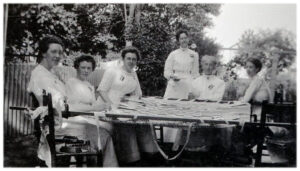
According to the International Quilt Study Center & Museum
“Women of the late 18th century, “the colonial era,” shared the work of quiltmaking out of necessity and pleasure. Research in women’s diaries and household inventories has shown that women shared textile work. Work parties of the period included barn raisings, harvestings, and huskings in addition to quilt parties.”
So the story goes that the first Quilting Bee in Hawai’i took place in 1820 onboard the ship named Thaddeus, anchored off Honolulu. This original Hawaiian Quilting Bee was held on the decks of the Thaddeus with two royal wives and their reigning chiefs in attendance. The missionary wives were their teachers.
The intriguing part of the history of Hawaiian Quilting is that Hawaiians had already been quilting, Hawaiian style, since ancient times. So it was natural that they quickly adapted to this new skill. They implemented their own creativity, culture, and native Hawaiian spirit into these beautiful creations.

Hawaiian Kapa
Hawaiian quilting began before the arrival of westerners to Hawai’i. It started with a material made from the inner bark of a Hawaiian plant called Wauke (mulberry tree). The bark is beaten and felted together into a fine cloth called Kapa. Hawaiians have been making Kapa since ancient times. Kapa was layered together and stitched on the edges like a quilt to make Kapa Moe, or a sleeping pad or blanket. It was also used for garments and swaddling for infants.
Early explorers thought the Hawaiian people had already been discovered by the west.
This was because the cloth they made their clothes from was so fine that they assumed they were made of imported cotton.
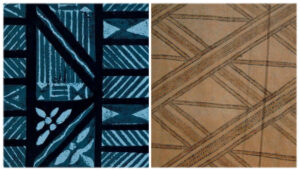
The fine, native fabric was decorated so exquisitely with watermarks and block stamps that in 1778, Captain James Cook wrote in his journal:
One would suppose that they [Hawaiians] had borrowed their patterns from some mercer’s shop in which the most elegant productions of China and Europe are collected, besides [having] some patterns of their own. The regularity of the figures and stripes is truly surprising.
The ancient art form of making and printing on Kapa was nearly lost (or hidden so as not to be lost).
Its revival began in the Hawaiian Renaissance of the 1970s. This was a time of resurrection, and many Hawaiian art forms were reclaimed.
The first Western ships began arriving in the 1800s, bringing in knowledge and missionaries from the outside world. It was then the missionary wives began to teach the Hawaiian women patchwork quilting. This was a quilting technique where small pieces of fabric were sewn together.
The Hawaiian women were puzzled. They did not see any reason to cut up a perfectly good, large amount of material into small pieces, just to sew it together again. Plus, the patchwork was too busy for them. It was so colorful that it was hard to see all their beautiful stitches.
The Hawaiian women wanted the stitches of the quilts to be a focal point.

In the middle of this evolution in Hawaiian Style Quilting came a sudden inspiration. The story goes that a Hawaiian woman watched her Keiki (children) learning to cut snowflakes from folded pieces of paper. Suddenly, she had an idea of using the same technique and applying it to cloth fabric. This moment was the beginning inspiration for the unique Hawaiian Quilt Design created by folding and cutting large pieces of fabric.
From snowflakes cut from folded paper came the ideas for the classic Hawaiian Quilt
Another legend tells the story of a Hawaiian woman who laid some fabric on the grass to dry. She noticed the shadows of the ulu (breadfruit) leaves dancing on the drying fabric. So she cut out the shadowy design of the ulu leaf and laid it onto another fabric. Then she quilted the cut-out, ulu design onto the fabric’s bottom layer, and the Hawaiian two-color Quilt was born.

Naturally, there are many inspirations for the designs of Hawaiian quilts.
These ideas come from vital objects like the ulu tree, which contain the powerful symbolism of abundance, growth, and nourishment.
Other inspirations came from the all-important natural world. Things like flowers, plants, wind, and rain are some of nature’s beauty that had already found expression in hula, songs, and poetry. These creative ideas were from integral parts of everyday life that slowly found their way to Hawaiian Quilt designs.
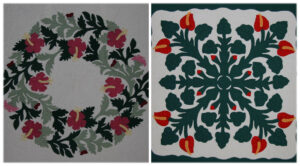
Hawaiian quilts can also evoke the memory of a loved one.
Queen Lili’uokalani was one of the most amazing quilters in Hawai’i. She succeeded her brother King David Kalākaua upon his death.
She was determined as Queen to strengthen the political power of the Hawaiian monarchy.

The Queen was opposed by powerful business interests and eventually imprisoned in her own palace. While in confinement, she made a beautiful and elaborate quilt. Each block tells a bit of the history and circumstances surrounding the tumultuous times she was living through.
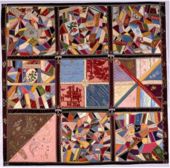
A great wave of patriotism filled the hearts of the Hawaiian People.
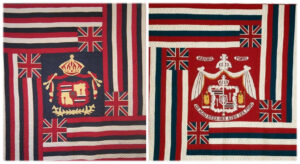
Hawaiian patriotism began to show up in Hawaiian quilting. The Hawaiian women began incorporating Hawaiian flag patterns and the Hawaiian National Motto onto bed quilts.
Because quilting has always been meaningful for bringing beauty into the home, staying warm, and as a relaxing hobby, these quilting bees have had many benefits. This is why they have continued to be popular within quilting communities.
Even today, as the Hawaiian Quilt has evolved, they remain true to form and an essential part of perpetuating the deep symbols significant to Hawaii’s culture and the lifestyle of the Hawaiian People.
Hawaiian quilts symbolize an attachment and love for the islands, which people share throughout the world.

Writing and Graphic Design by Sugandha Ferro Black

Photos courtesy of paid-for or free sources unless otherwise noted.
Flag quilts | © Naional Mus of America/flickr, Stitching a Quilt | © Volcano Natl Park Public Domain/flickr, Making Kapa | © Alphones Pellion 1819 Public Domain/wiki, Queen’s Quilt | © Public Domain/wiki, Quilting Bee |